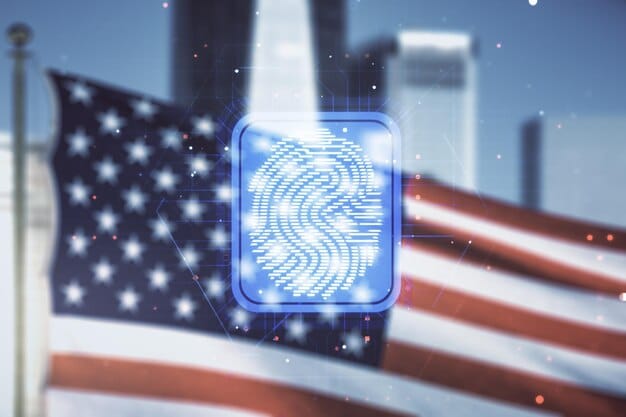US-EU Data Privacy Agreement: Key Provisions & National Security Impact

The new US-EU Data Privacy Framework introduces stricter data protection standards, including enhanced safeguards for EU citizens’ data, limitations on US intelligence access, and new redress mechanisms, aiming to reconcile privacy rights with legitimate national security needs.
In an increasingly interconnected world, the flow of data between continents is vital for economic and social development. However, this movement of information also brings complex challenges, particularly concerning privacy and national security. Understanding what are the key provisions of the new US-EU data privacy agreement and their impact on national security is crucial for individuals, businesses, and governments alike.
Establishing the Trans-Atlantic Data Privacy Framework
The relationship between the United States and the European Union concerning data privacy has long been a complex dance, balancing economic necessity with fundamental rights. The new Trans-Atlantic Data Privacy Framework represents the latest attempt to bridge distinct legal and philosophical approaches to data protection after the previous “Privacy Shield” was invalidated. This framework aims to provide a stable, reliable mechanism for data transfers, addressing concerns raised by the European Court of Justice (ECJ).
Historically, the ECJ struck down past agreements like Safe Harbor and Privacy Shield due to perceived inadequacies in protecting EU citizens’ data from US government surveillance. These rulings created significant legal uncertainty for thousands of companies relying on these mechanisms for data transfers. The pressure mounted for a durable solution that respected both sides’ interests.
The Genesis of the New Framework
- Addressing ECJ Concerns: The primary motivation was to directly respond to the Schrems II ruling, which highlighted insufficient safeguards against US government access to EU data and a lack of effective redress mechanisms for EU citizens.
- Economic Imperative: Billions of dollars in digital trade depend on reliable data flows. Without a solid legal foundation, businesses faced operational hurdles and potential legal liabilities.
- Political Will: High-level diplomatic engagement was necessary to negotiate the complex points of convergence and divergence between US intelligence practices and EU data protection laws.
The framework seeks to reinforce trust and continuity, allowing transatlantic commerce to thrive while upholding the fundamental right to privacy. Its establishment was a meticulous process, involving extensive negotiations and legal analysis to ensure compliance with both US law and EU regulations, specifically the General Data Protection Regulation (GDPR). This intricate negotiation demonstrates the commitment from both sides to find common ground on a critical issue of global digital governance.
Key Provisions of the Data Privacy Framework
The new US-EU Data Privacy Framework introduces several pivotal provisions designed to enhance the protection of European data as it crosses the Atlantic. These provisions are the bedrock of the agreement, aiming to create a system that is both robust and legally sound, thereby assuaging the concerns previously raised by European regulators and courts.
One of the most significant changes lies in the limitations placed on U.S. intelligence access to data. Under the previous arrangements, a primary point of contention was the perceived lack of oversight and broad authority for U.S. intelligence agencies to access data transferred from the EU. The new framework directly addresses this by introducing more stringent conditions and increased oversight.
Enhanced Protections and Limitations
- Necessity and Proportionality: U.S. intelligence agencies must now adhere to principles of necessity and proportionality when accessing data, meaning data collection must be necessary to advance a validated national security objective and be proportionate to that objective. This is a crucial alignment with EU legal standards.
- Binding Safeguards: New legally binding safeguards have been implemented, codifying the commitment that access to data by U.S. intelligence agencies will be limited to what is necessary and proportionate to protect national security.
- Expanded Redress Mechanisms: For the first time, EU individuals gain access to a multi-layered redress mechanism. This includes an independent Data Protection Review Court (DPRC) established within the U.S. Department of Justice, providing a tangible avenue for EU citizens to seek recourse regarding U.S. intelligence data practices.
Beyond these, the framework retains core principles from its predecessors, such as the requirement for participating U.S. companies to self-certify their adherence to a set of privacy principles including notice, choice, accountability for onward transfer, security, data integrity, access, and recourse. These principles are aligned with the fundamental tenets of the GDPR, ensuring a baseline of protection for personal data. The Department of Commerce oversees the self-certification process, while the Federal Trade Commission (FTC) enforces compliance.

Impact on National Security: Balancing Acts
The new US-EU Data Privacy Framework undeniably introduces tighter constraints on how U.S. intelligence agencies can access data originating from the European Union. This shift reflects a delicate balancing act between the imperative of national security and the fundamental right to privacy. For U.S. authorities, the agreement means adapting existing practices to meet the criteria of necessity and proportionality, a concept deeply ingrained in European law but relatively new in explicit application to foreign intelligence surveillance in this context.
The U.S. government has affirmed that its intelligence activities are already conducted with safeguards and oversight. However, the framework solidifies these protections into legally binding commitments, including the establishment of an independent Data Protection Review Court. This court has the authority to review decisions and order remedial measures where necessary, offering EU citizens a robust and independent avenue for redress that did not exist previously.
Implications for Intelligence Operations
- Refined Data Collection: U.S. intelligence agencies will need to ensure their data collection practices align with the necessity and proportionality principles, likely leading to more targeted and specific requests.
- Increased Scrutiny: The existence of the Data Protection Review Court means that intelligence activities involving EU data will be subject to an unprecedented level of external, independent judicial review.
- Enhanced Transparency: While specific operational details of intelligence gathering remain classified, the framework fosters a greater degree of transparency regarding the overarching principles and oversight mechanisms governing U.S. intelligence access to data.
The framework attempts to demonstrate that the U.S. can uphold robust national security while simultaneously respecting individual privacy rights. It provides a legal basis that the ECJ has, in the past, required: a legal instrument that truly limits government access to data and provides effective judicial remedy. This move is crucial not only for maintaining vital intelligence partnerships with European allies but also for fostering trust in transatlantic data flows, which are essential for both economic prosperity and collaborative security efforts.
Addressing Criticisms and Future Challenges
Despite the significant efforts invested in crafting the new US-EU Data Privacy Framework, it has not escaped criticism. Skepticism largely emanates from privacy advocates and some legal scholars in Europe, who question whether the safeguards introduced are genuinely sufficient to withstand future legal challenges, particularly another review by the European Court of Justice. The core of their concern often revolves around the inherent differences between the U.S. and EU legal systems regarding surveillance and redress.
One major point of contention centers on the Data Protection Review Court (DPRC). Critics argue that while the DPRC is an improvement, it operates under an executive order (Executive Order 14086) rather than statute, which some legal perspectives view as less durable or less binding than a legislative act. Furthermore, the secrecy surrounding intelligence operations naturally limits the transparency of the redress process, even with an independent court. This is a fundamental tension that the framework attempts to navigate but may not fully resolve in the eyes of its most ardent critics.
Persistent Areas of Concern
- Executive Order vs. Statute: The legal basis of the DPRC through an executive order rather than an act of Congress leaves some concerned about its long-term stability and enforceability across administrations.
- Effectiveness of Redress: While improved, questions linger about the true effectiveness and transparency of redress mechanisms for EU citizens, given the classified nature of intelligence activities.
- “Essential Equivalence” Criterion: The ECJ’s “essential equivalence” standard for data protection still poses a high bar, and critics question if the new framework truly meets this rigorous benchmark, especially concerning mass surveillance practices.
Looking ahead, the framework faces the formidable challenge of proving its durability. It is highly probable that it will be subject to scrutiny and legal challenges, potentially leading to another ruling by the European Court of Justice. The success of the framework ultimately hinges on whether its provisions can effectively bridge the philosophical divide between U.S. national security imperatives and EU fundamental rights to privacy in a manner that satisfies judicial review. Businesses and governments involved will need to closely monitor these developments to ensure ongoing compliance and legal certainty.
Implications for Businesses and Digital Economy
The establishment of a stable and predictable legal framework for transatlantic data flows is a significant relief for thousands of businesses operating across the U.S. and the EU. For years, legal uncertainty surrounding data transfers had cast a shadow over digital commerce, forcing companies to explore complex and often costly alternative transfer mechanisms, or even to localize data within the EU to mitigate risk. The new Data Privacy Framework is intended to normalize these essential data exchanges, fostering an environment where digital trade can flourish without constant legal apprehension.
Businesses of all sizes, from tech giants to small and medium-sized enterprises (SMEs), rely heavily on the ability to transfer personal data—whether it’s employee information, customer data for service delivery, or operational data for cloud computing. The absence of a robust, legally sound framework could stifle innovation, increase operational costs, and create barriers to market entry. The new agreement seeks to provide a clear path forward, allowing companies to focus on growth and service delivery rather than navigating a fragmented regulatory landscape.
Operational Benefits and Challenges
- Legal Certainty: Companies can now rely on a certified mechanism, reducing the legal and compliance risks associated with data transfers previously subject to challenge.
- Reduced Burden: While compliance requirements remain, the framework simplifies the process compared to individually negotiated standard contractual clauses (SCCs) for every data transfer.
- Continued Due Diligence: Businesses will still need to perform due diligence to ensure that their third-party vendors and partners participating in the framework adhere to its principles. Ongoing compliance monitoring is crucial.
While the framework offers substantial benefits, businesses must remain vigilant. They are still responsible for understanding the specifics of the framework, ensuring their own data handling practices align with its principles, and maintaining records of compliance. Furthermore, they should stay informed about any potential future legal challenges or regulatory updates. The goal is not just to transfer data, but to do so responsibly and legally, maintaining consumer trust and avoiding costly legal disputes. This framework provides the essential legal scaffolding for continued digital economic integration between the two largest economic blocs.
Geopolitical Dimensions and International Standards
The new US-EU Data Privacy Framework transcends mere legal and economic considerations; it carries significant geopolitical weight and serves as a bellwether for international data governance. In an era where data is increasingly seen as a strategic asset, the agreement between two of the world’s largest democratic economies sends a powerful signal about the importance of aligning data protection with fundamental rights, even amidst national security concerns. This bilateral effort also influences the global discourse on how nations can establish interoperable data transfer mechanisms that respect diverse legal traditions.
The agreement between the U.S. and E.U. can be viewed as a foundational step towards harmonizing digital trade and privacy standards among like-minded democratic allies. This is particularly relevant in contrast to data governance models espoused by authoritarian regimes, which often prioritize state control over individual privacy. By demonstrating a workable solution that balances privacy and security, the framework could potentially serve as a model for other bilateral or multilateral agreements, fostering a more trusted and open global internet.
Wider Implications for Global Data Governance
- Setting a Precedent: The framework demonstrates that robust data protection and legitimate national security needs are not mutually exclusive, offering a blueprint for other regions.
- Strengthening Alliances: A stable data flow mechanism solidifies the economic and strategic alliance between the U.S. and E.U., enabling closer collaboration on technological and security fronts.
- Influencing Future Agreements: The rigorous scrutiny applied to this framework, particularly by the ECJ, sets a high bar for data protection standards that other nations or blocs may consider in their own agreements.
However, the geopolitical context also means that the framework’s stability is tied to the broader U.S.-EU relationship and evolving global digital threats. Its success would underscore the ability of democratic nations to collaboratively establish rules for a free and open internet that prioritizes trust. Conversely, if it faces significant legal setbacks, it could highlight the persistent challenges in achieving global interoperability in data protection, potentially leading to increased data localization pressures and a more fragmented internet. The ongoing dialogue and commitment to these principles will be crucial for shaping the future landscape of global data governance.

Navigating Compliance for Organizations
For organizations, both in the U.S. and the EU, understanding and navigating the compliance requirements of the new data privacy framework is paramount. While the framework aims to simplify transatlantic data transfers, it does not absolve companies of their responsibilities under existing data protection laws, most notably the General Data Protection Regulation (GDPR) in the EU and various state and federal privacy laws in the U.S. Instead, it provides a specific, legally recognized mechanism for transfers, upon which companies can rely.
The first step for U.S. companies wishing to leverage the framework is to self-certify with the Department of Commerce. This involves committing to adhere to the framework’s principles, which broadly align with GDPR’s core tenets, such as purpose limitation, data minimization, data security, and individual rights. This self-certification is not a one-time event; it requires ongoing commitment and annual re-certification. Furthermore, organizations must have internal mechanisms in place to handle individual inquiries and complaints, providing an initial layer of redress.
Key Actions for Compliance
- Self-Certification: U.S. organizations must apply for and maintain their certification under the Data Privacy Framework with the U.S. Department of Commerce.
- Update Privacy Policies: Companies need to update their privacy policies to reflect their participation in the framework and clearly explain how personal data is processed and protected.
- Implement Internal Procedures: Establish clear internal procedures for handling data, including security measures, data retention policies, and processes for responding to data subject requests.
- Vendor Management: Ensure that any third-party processors or vendors handling EU data also comply with the framework’s principles or other suitable transfer mechanisms.
For EU organizations, the framework provides an “adequacy decision” from the European Commission, meaning that data transferred to certified U.S. organizations is considered to have “adequate” protection. This simplifies their compliance burden compared to relying solely on standard contractual clauses. However, EU companies still have an obligation to verify that the U.S. entity they are transferring data to is indeed certified under the framework. Ongoing due diligence and awareness of the framework’s evolution will be critical for maintaining compliant and secure data flows. The success of the framework depends on diligent adherence by all participating entities.
| Key Provision | Brief Description |
|---|---|
| 🇪🇺 Enhanced Safeguards | U.S. intelligence access to EU data limited by necessity and proportionality. |
| ⚖️ Redress Mechanism | New independent Data Protection Review Court (DPRC) for EU individuals. |
| ✅ Business Certification | U.S. companies self-certify compliance with data privacy principles. |
| 🌐 Geopolitical Impact | Reinforces transatlantic trust and sets a precedent for global data governance. |
Frequently Asked Questions About the US-EU Data Privacy Agreement
The primary goal is to provide a stable, legally sound mechanism for transatlantic data transfers, addressing past concerns about U.S. government access to EU data while enabling continued digital commerce and cooperation between the two regions. It aims to reconcile privacy rights with national security needs.
The framework introduces legally binding safeguards, requiring U.S. intelligence agencies to limit access to EU data based on necessity and proportionality. This means data collection must be targeted and proportionate to a validated national security objective, aligning with EU legal standards.
EU citizens now have access to a multi-layered redress mechanism, including an independent Data Protection Review Court (DPRC) established within the U.S. Department of Justice. This court can review complaints regarding U.S. intelligence access to data and order remedial measures.
No, U.S. businesses must self-certify their adherence to the framework’s privacy principles with the U.S. Department of Commerce. This involves an application process and ongoing annual re-certification, ensuring they meet the specified data protection standards for handling EU personal data.
Critics primarily question the durability of the framework, especially its reliance on an executive order for the DPRC rather than a statute, and whether its safeguards truly meet the “essential equivalence” standard required by the European Court of Justice, which may lead to future legal challenges.
Conclusion
The new US-EU Data Privacy Framework emerges as a pivotal agreement, reflecting a concerted effort to reconcile the complex interplay between data privacy and national security in a digital age. By introducing more stringent safeguards for European data and establishing robust redress mechanisms—features previously lacking—it aims to provide the legal certainty essential for transatlantic data flows. While challenges and criticisms persist, particularly regarding its long-term legal resilience, the framework represents a significant step towards fostering trust and stability in global digital commerce. Its success will not only benefit businesses and individuals but also stands as a testament to the ability of democratic allies to collaboratively shape international data governance standards.





